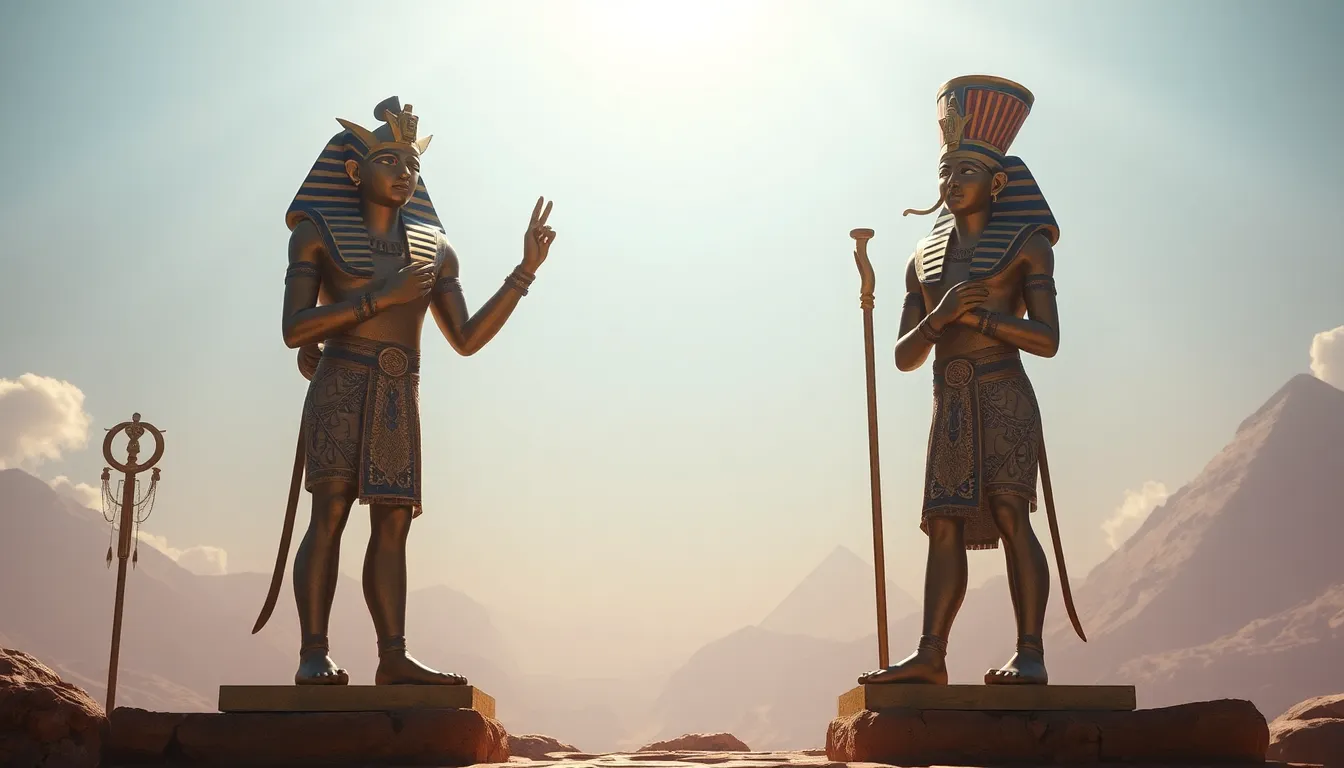The Divine Spectrum: Exploring the Range of Egyptian Myths
I. Introduction to Egyptian Mythology
Egyptian mythology is a rich tapestry of stories and beliefs that shaped the lives of the ancient Egyptians. These myths served not only as explanations for natural phenomena but also as a means to understand the universe and humanity’s place within it.
At the heart of Egyptian mythology is a pantheon of gods and goddesses, each representing different aspects of life, nature, and the cosmos. This divine hierarchy reflects the complexities of the world around the Egyptians, offering insights into their values, fears, and hopes.
Mythology played a crucial role in Egyptian culture and society, influencing everything from religion and art to politics and daily life. The myths were not merely stories; they were foundational beliefs that guided the actions and thoughts of Egyptians throughout their history.
II. Creation Myths: The Birth of the Cosmos
Egyptian creation myths are diverse, with different gods taking center stage in various narratives. Among the most significant creation stories are those involving Atum, Ptah, and Amun.
- Atum: Often depicted as the original creator god, Atum is said to have created himself from the primordial waters of chaos, represented by the Nu. He then created the first gods and goddesses, giving birth to the cosmos.
- Ptah: Worshipped in Memphis, Ptah is credited with creating the universe through thought and word. He is considered a god of craftsmen and builders.
- Amun: Amun emerged as a significant creator deity, particularly during the New Kingdom, symbolizing the hidden and the unseen. His association with the sun and air emphasized the connection between creation and life.
The Nile River holds great significance in these creation myths. It is not only a source of life and sustenance but also seen as a divine element that facilitated the birth of civilization itself.
Common themes in Egyptian creation myths include the emergence of order from chaos and the continual struggle between different forces, reflecting the Egyptians’ understanding of their world.
III. Major Deities and Their Domains
The Egyptian pantheon is populated with a multitude of deities, each overseeing different aspects of life and the universe. Some of the most notable gods and goddesses include:
- Ra: The sun god, symbolizing light, warmth, and growth.
- Osiris: The god of the afterlife and resurrection, representing fertility and agriculture.
- Isis: A powerful goddess of magic and motherhood, revered as the protector of the downtrodden.
- Horus: The sky god, often depicted as a falcon, representing kingship and protection.
- Anubis: The god of mummification and the afterlife, associated with guiding souls to the underworld.
These deities embody the values and beliefs of ancient Egyptians, reflecting their reverence for nature, the importance of the afterlife, and the need for balance and order in society.
IV. Myths of Death and the Afterlife
Central to Egyptian mythology is the concept of the afterlife, which was seen as a continuation of life on earth. The story of Osiris is particularly significant in this context.
Osiris, once a king of Egypt, was murdered by his brother Set, who desired power. However, Osiris’s wife, Isis, used her magical abilities to resurrect him. This myth underscores the themes of death, resurrection, and the promise of life after death.
Funerary practices in ancient Egypt were heavily influenced by mythology, as they believed that proper rituals would ensure a safe passage to the afterlife. The Book of the Dead, a collection of spells and prayers, was commonly buried with the deceased to assist them on their journey.
V. Myths of Creation and Order
Ma’at is a fundamental concept in Egyptian mythology, symbolizing truth, balance, and cosmic order. The idea of Ma’at reflects the Egyptians’ belief in the importance of harmony within the universe.
Stories illustrating the battle between chaos and order often involve the conflict between Set and Horus. Set represents chaos and disorder, while Horus embodies justice and protection. Their struggles are emblematic of the constant fight to maintain balance in both the cosmos and society.
Understanding and upholding Ma’at was crucial for Egyptians, as it influenced their laws, morals, and daily practices.
VI. Gender Roles in Egyptian Myths
Egyptian mythology presents a complex portrayal of gender roles, particularly through the depiction of female deities. Many powerful goddesses, such as Isis and Hathor, were central to religious and social life.
Myths featuring these goddesses often highlight their strength, intelligence, and nurturing qualities, challenging the notion of patriarchal dominance in ancient societies. Women held significant roles in both mythology and reality, with many acting as priestesses or influential figures in their communities.
Furthermore, fertility and motherhood are celebrated through various myths, showcasing the reverence for women and their contributions to society.
VII. Mythological Creatures and Symbolism
Mythological creatures play a vital role in Egyptian lore, often embodying various traits and symbols. Some notable creatures include:
- Sphinx: A symbol of wisdom and protection, often depicted with the body of a lion and the head of a human.
- Griffin: A creature with the body of a lion and the head of an eagle, symbolizing strength and vigilance.
These creatures often reflect societal fears and aspirations, serving as guardians of sacred spaces or embodying ideals of power and protection.
VIII. Conclusion: The Enduring Legacy of Egyptian Myths
The influence of Egyptian mythology extends far beyond the borders of ancient Egypt, impacting modern culture, literature, and spirituality. Elements of these myths continue to resonate in contemporary discussions about morality, life, and the universe.
As we study and preserve these ancient tales, we gain valuable insights into the human experience, the complexities of life, and the enduring quest for understanding our place in the cosmos.
In conclusion, the rich tapestry of Egyptian mythology offers a profound legacy that encourages ongoing exploration, appreciation, and respect for the cultural heritage of one of history’s most fascinating civilizations.




